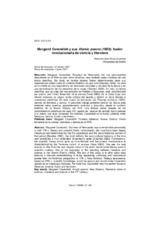Mostrar el registro sencillo del ítem
Margaret Cavendish y sus Atomic poems (1653): fusión revolucionaria de ciencia y literatura
| dc.contributor.author | Rivas Carmona, M. del Mar | |
| dc.date.accessioned | 2019-07-22T06:55:10Z | |
| dc.date.available | 2019-07-22T06:55:10Z | |
| dc.date.issued | 2008 | |
| dc.identifier.issn | 1579-9794 | |
| dc.identifier.uri | http://hdl.handle.net/10396/18878 | |
| dc.description.abstract | Margaret Cavendish, Duquesa de Newcastle, fue una personalidad descollante en el XVII no sólo como escritora, sino también como creadora de una teoría científica. Sin duda, en ambas labores fueron determinantes tanto sus experiencias vitales como el contexto histórico en que vivió (Bazeley 1990). Su obra se convierte en una respuesta a las tensiones culturales y sociales de la época y en una reivindicación de los derechos de la mujer (Charlton 2002). Es más, su teoría científica, que se aleja del mecanicismo de Hobbes y Descartes, está caracterizada por poseer una “visión femenina” de la ciencia (Rees 2003). Es la única mujer que ofreció entonces su propia visión utópica del mundo y dedicó su labor literaria a cuestiones científicas. En este marco se enmarcan sus Poemas atómicos (1653), mezcla de literatura y ciencia. El presente trabajo pretende ofrecer las claves para entender estos poemas, aparentemente confusos y absurdos, desde el contexto histórico de la Nueva Ciencia del XVII. Una lectura actual basada en los conocimientos científicos del siglo XXI, aparte de carecer de sentido, haría parecer a la autora una ilusa visionaria. En realidad, Cavendish es la fusión perfecta entre literatura, ciencia, ficción y feminismo. | es_ES |
| dc.description.abstract | Margaret Cavendish, Duchess of Newcastle, was a remarkable personality in both 17th c. literary and scientific fields. Undoubtedly, she must have been deeply influenced and determined by her life experience and the socio-historical context of that period (Bazeley 1990). Her work reflects the socio-cultural tensions of the time and constitutes a true vindication of women‟s rights (Charlton 2002). Furthermore, her scientific theory, which splits up from Hobbes and Descartes‟s mechanicism, is characterized by her “feminine vision” of science (Rees 2003). She was the only woman to offer then her own utopian vision of the world devoting her literary work to scientific matters. One of the examples of this blending between literature and science is her Atomic Poems (1653). The aim of this study is to offer some keys towards a relevant understanding of these apparently confusing and nonsensical poems from the historical perspective of 17th c. New Science. Today‟s perspective, based on 21th c. scientific knowledge, would be absurd and would make Cavendish appear as an ingenuous visionary. Far from that, Cavendish was the perfect fusion of literature, science, fiction and feminism. | es_ES |
| dc.format.mimetype | application/pdf | es_ES |
| dc.language.iso | spa | es_ES |
| dc.publisher | UCOPress | es_ES |
| dc.rights | https://creativecommons.org/licenses/by-nc-nd/4.0/ | es_ES |
| dc.source | Hikma 7, 87-108 (2008) | es_ES |
| dc.subject | Cavendish, Margaret, 1623-1674 | es_ES |
| dc.subject | Poemas atómicos | es_ES |
| dc.subject | Nueva Ciencia | es_ES |
| dc.subject | Visión femenina de la ciencia | es_ES |
| dc.subject | Literatura y ciencia en el XVII | es_ES |
| dc.subject | Atomic poems | es_ES |
| dc.subject | New Science | es_ES |
| dc.subject | Feminine vision of science | es_ES |
| dc.subject | Literature and science in the 17th century | es_ES |
| dc.title | Margaret Cavendish y sus Atomic poems (1653): fusión revolucionaria de ciencia y literatura | es_ES |
| dc.type | info:eu-repo/semantics/article | es_ES |
| dc.relation.publisherversion | https://www.uco.es/ucopress/ojs/index.php/hikma/index | es_ES |
| dc.rights.accessRights | info:eu-repo/semantics/openAccess | es_ES |

